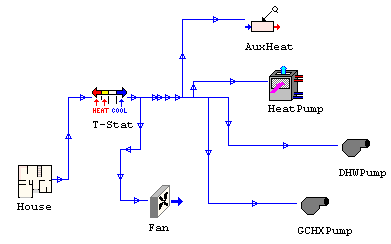



The TRNSYS simulation program has been used to
model one of the hottest technologies in the HVAC market today;
ground source heat pumps. Ground source heat pumps use the earth
as a thermal reservoir to provide conditioned air for heating and
cooling of buildings. ![]()
When the thermostat calls for cooling, the fan will move air from the building to the heat pump where it is cooled as it crosses the cooling coil. The cool air is then dumped back into the building until the thermostat is satisfied. The heat removed from the air and transferred to the refrigerant is then rejected to a cooling fluid stream (typically water in southern climates). This hot fluid is then pumped to ground heat exchangers that are buried in the earth where the heat is transferred to the soil.
In heating mode, this process is reversed. When the thermostat calls for heating, the fan will move air from the building to the heat pump where it is heated as it crosses the heating coil. This warm air is then dumped back into the building until the thermostat is satisfied. If the thermostat calls for auxiliary heating, an electric resistance heater located at the air outlet from the heat pump will heat the air up even further. The heat absorbed by the air from the refrigerant is removed from the fluid stream. This cool fluid is then sent to the ground heat exchangers to absorb energy from the soil so that the process may be repeated.
The heat pump for this simulation has an option
for heating hot water by the use of a desuperheater. While
operating in either heating or cooling mode, cool water is
removed from the bottom of the hot water storage tank and passed
across the desuperheater of the heat pump. Energy is transferred
from the refrigerant to the water by the desuperheating of the
refrigerant. The hot water is then pumped back to the top of the
hot water storage tank for later use. ![]()
A more detailed description of the operation of the following
heat pump systems is also available:
![]()
Using TRNSYS, the following questions can easily be answered:
Plus many, many more! ![]()
In TRNSYS, the ground source heat pump
application is very easy to create. Using the new graphical
interface for TRNSYS called IISiBat, the icons representing each
of the system components (heat pump, storage tank, ground heat
exchangers, printers, etc.) are dragged onto the assembly panel.
The parameters for each of these components are filled in and the
connections between the components are established (fluid flow
from the ground heat exchangers to the heat pump for example). A
screen capture of the ground heat pump system being created in
TRNSYS/IISiBat can be viewed by clicking here.
![]()
After specifying the start and stop times for the simulation, the IISiBat program writes a TRNSYS input file that can be run, modified, and analyzed from within IISiBat. The IISiBat program also writes the input file in a special format called TRNSED format. This format hides the details of TRNSYS from other users; displaying only the information that is deemed important by the creator of the application. A screen capture from the TRNSED program for this application can be viewed by clicking here.
The TRNSED program features pop-up menus and
input boxes for the specification of the system parameters. Users
may run the simulations and view the results all from within the
program. The TRNSED program may then be distributed to clients
for analysis without your clients ever having to learn the TRNSYS
software! ![]()
To show the power of the TRNSED and TRNSYS
programs, the ground source heat pump application in TRNSYS may
be downloaded by clicking here. ![]()
NOTE: There are several non-standard TRNSYS components used in this TRNSED demonstration. The components (including the Ground Loop and the Heat Pump component) are available from TESS for an additional fee.